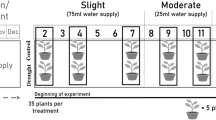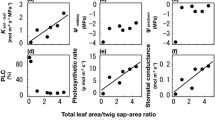Abstract
In tropical dry forests (TDF), most woody species tolerate annual drought periods via a deciduous life history strategy. However, TDF also present evergreen trees, which are supposed to develop different traits to tolerate the dry season. Herein, we investigated the physiological traits in the leaf, stem, and root of the evergreen shrub Cynophalla flexuosa. In these three organs, we measured non-structural carbohydrate (NSC) concentration, and nitrogen (N), phosphorus (P), and potassium (K) concentration. The traits xylem water potential (ð) and stomatal conductance (gs) was also measured. We reported high stability of gs throughout the seasons, despite high variation in soil moisture and vapor pressure deficit. The leaf morphoanatomy such as hypostomatic distribution and the papillose groove structure above stomata might be supporting that response. In all seasons, Yx declined every morning but was fully recovered by the evening. Storage and redistribution of NSC and N, P, and K among tissues appeared to be regulated more by C. flexuosa phenophases than by environmental water availability. During the dry season, the plants presented resprouting leaves, high NSC concentration in the leaf and root, and high N concentration in the leaf and stem. These results suggest that high NSC root concentrations is crucial for maintaining high water uptake efficiency during all seasons. Our results suggest that drought tolerance of the woody evergreen C. flexuosa in a tropical dry forest is achieved via mobilization of non-structural carbohydrates and nutrients and rapid daily recovery of water status.







Similar content being viewed by others
References
Ahmad I, Devonshire J, Mohamed R, Schultze M, Maathuis FJM (2016) Overexpression of the potassium channel TPKb in small vacuoles confers osmotic and drought tolerance to rice. New Phytol 209:1040–1048. https://doi.org/10.1111/nph.13708
Barros V, Oliveira MT, Santos MG (2021) Low foliar construction cost and Strong investment in root biomass in Calotropis procera, an invasive species under drought and recovery. Flora. https://doi.org/10.1016/j.flora.2021.151848
Boyer JS (1988) Cell enlargement and growth-induced water potentials. Physiol Plant 73:311–316. https://doi.org/10.1111/j.1399-3054.1988.tb00603.x
Campbell G, Norman J (1998) An introduction to environmental biophysics, 2nd edn. Springer, New York
Chapin SF, Schulze ED, Mooney HA (1990) The ecology and economics of storage in plants. Annu Rev Ecol Syst 21:432–447. https://doi.org/10.1146/annurev.es.21.110190.002231
Chaves MM, Costa JM, Zarrouk O, Pinheiro C, Lopes CM, Pereira JS (2016) Controlling stomatal aperture in semi-arid regions-the dilemma of saving water or being cool? Plant Sci 251:54–64. https://doi.org/10.1016/j.plantsci.2016.06.015
Choat B, Jansen S, Brodribb TJ, Cochard H et al (2012) Global convergence in the vulnerability of forests to drought. Nature 491:752–756. https://doi.org/10.1038/nature11688
Dietze MS, Sala N, Carbone MS, Czimczik CI, Mantooth JA, Richardson AD, Vargas R (2014) Nonstructural carbon in woody plants. Ann Rev Plant Biol 65:667–687. https://doi.org/10.1146/annurev-arplant-050213-040054
Dong S, Beckles DM (2019) Dynamic changes in the starch-sugar interconversion within plant source and sink tissues promote a better abiotic stress response. J Plant Physiol 235:80–93. https://doi.org/10.1016/j.jplph.2019.01.007
Dong S, Zhang J, Beckles DM (2018) A pivotal role for starch in the reconfiguration of 14C-partitioning and allocation in Arabidopsis thaliana under short-term abiotic stress. Sci Rep. https://doi.org/10.1038/s41598-018-27610-y
Dubois M, Gilles K, Hamilton J, Rebers P, Smith F (1956) Colorimetric method for determination of sugars and related substances. Anal Chem 28:350–356. https://doi.org/10.1021/ac60111a017
EMBRAPA – Empresa Brasileira de Pesquisa Agropecuária (1998) Manual de análises químicas de solos, plantas e fertilizantes. Brasília: Embrapa Solos/Embrapa Informática Agropecuária/Embrapa Comunicação para Transferência de Tecnologia, 370.
Fajardo A, Piper FI (2021) How to cope with drought and not die trying: drought acclimation across tree species with contrasting niche breadth. Funct Ecol 35:1903–1913. https://doi.org/10.1111/1365-2435.13861
Falcão HM, Medeiros CD, Almeida-Cortez J et al (2017) Leaf construction cost is related to water availability in three species of different growth forms in a Brazilian tropical dry forest. Theor Exp Plant Physiol 29:95–108. https://doi.org/10.1007/s40626-017-0087-9
Figueiredo-Lima KV, Falcão HM, Melo-de-Pina GF, Albacete A et al (2018) Leaf phytohormone levels and stomatal control in an evergreen woody species under semiarid environment in a Brazilian seasonally dry tropical forest. Plant Grow Regul. 85(3):437–445. https://doi.org/10.1007/s10725-018-0405-5
Frosi G, Harand W, Oliveira MT, Pereira S et al (2017) Different physiological responses under drought stress result in different recovery abilities of two tropical woody evergreen species. Acta Bot Bras 31:153–160. https://doi.org/10.1590/0102-33062016abb0375
Garten CT, Gentry JB, Sharitz RR (1977) An analysis of elemental concentrations in vegetation bordering a southeastern united states coastal plain stream. Ecology 58:979–992. https://doi.org/10.2307/1936919
Hartmann H (2015) Carbon starvation during drought-induced tree mortality – are we chasing a myth. J Plant Hydraul. https://doi.org/10.20870/jph.2015.e005
Hartmann H, Trumbore S (2016) Understanding the roles of nonstructural carbohydrates in forest trees – from what we can measure to what we want to know. New Phytol 211:386–403. https://doi.org/10.1111/nph.13955
He M, Dijkstra FA (2014) Drought effect on plant nitrogen and phosphorus: a meta-analysis. New Phytol 204:924–931. https://doi.org/10.1111/nph.12952
IPCC, 2021: Summary for Policymakers. In: Climate Change 2021: The Physical Science Basis. Contribution of Working Group I to the Sixth Assessment Report of the Intergovernmental Panel on Climate Change [Masson-Delmotte, V., P. Zhai, A. Pirani, S. L. Connors, C. Péan, S. Berger, N. Caud, Y. Chen, L. Goldfarb, M. I. Gomis, M. Huang, K. Leitzell, E. Lonnoy, J.B.R. Matthews, T. K. Maycock, T. Waterfield, O. Yelekçi, R. Yu and B. Zhou (eds.)]. Cambridge University Press. In Press.
Larcher W (1995) Physiological plant ecology. Berlim, Springer-Verlag
Larter M, Pfautsch S, Domec JC, Trueba S et al (2017) Aridity drove the evolution of extreme embolism resistance and the radiation of conifer genus Callitris. New Phytol 215:97–112. https://doi.org/10.1111/nph.14545
Lawson T, Blatt MR (2014) Stomatal size, speed, and responsiveness impact on photosynthesis and water use efficiency. Plant Physiol 164:1556–1570. https://doi.org/10.1104/pp.114.237107
Lima L, Frosi G, Lopes R, Santos MG (2021) Remobilization of leaf Na+ content and use of nonstructural carbohydrates vary depending on the time when salt stress begins in woody species. Plant Physiol Biochem 158:385–395. https://doi.org/10.1016/j.plaphy.2020.11.026
Liu W, Su J, Li S, Lang X, Huang X (2018) Non-structural carbohydrates regulated by season and species in the subtropical monsoon broadleaved evergreen forest of Yunnan Province. China Scientific Reports. https://doi.org/10.1038/s41598-018-19271-8
Marengo JA, Torres RR, Alves LM (2017) Drought in Northeast Brazil—past, present, and future. Theor Appl Climatol 129:1189–1200. https://doi.org/10.1007/s00704-016-1840-8
McDowell N, Pockman T, Allen CD, Breshears DD et al (2008) Mechanisms of plant survival and mortality during drought: why do some plants survive while others succumb to drought? New Phytol 178:719–739. https://doi.org/10.1093/treephys/22.11.763
Melo A, Yule T, Barros V, Rivas R, Santos MG (2021) C3-species Calotropis procera increase specific leaf área and decrease stomatal pore size, alleviating gas exchange under drought and salinity. Acta Physiol Plant 43:140. https://doi.org/10.1007/s11738-021-03312-3
Milla R, Castro-Díez P, Maestro-Martínez M, Montserrat-Martí G (2005) Relationships between phenology and the remobilization of nitrogen, phosphorus and potassium in branches of eight Meiterranean evergreens. New Phytol 168:167–178. https://doi.org/10.1111/j.1469-8137.2005.01477.x
Moro MF, Lughadha EN, Araújo FS, Martins R et al (2016) A phytogeographical meta-analysis of the semiarid Caatinga domain in Brazil. Bot Rev. https://doi.org/10.1007/s12229-016-9164-z
Munné-Bosch S, Alegre L (2004) Die and let live: leaf senescence contributes to plant survival under drought stress. Funct Plant Biol 31:203–216. https://doi.org/10.1071/FP03236
Murphy J, Riley JPA (1962) A modified simple solution method for the determination of phosphate in natural waters. Anal Chim Acta 27:31–36. https://doi.org/10.1016/S0003-2670(00)88444-5
Oliveira MT, Souza GM, Gustavo M, Pereira S, Oliveira DAS, Figueiredo-Lima KV, Arruda E, Santos MG (2017) Seasonal variability in physiological and anatomical traits contributes to invasion success of Prosopis juliflora in tropical dry forest. Tree Physiol 37:326–337. https://doi.org/10.1093/treephys/tpw123
Palacio S, Camarero JJ, Maestro M et al (2018) Are storage and tree growth related? Seasonal nutrient and carbohydrate dynamics in evergreen and deciduous Mediterranean oaks. Trees 32:777–790. https://doi.org/10.1007/s00468-018-1671-6
Pereira S, Figueiredo-Lima K, Oliveira AFM, Santos MG (2019) Changes in foliar epicuticular wax and photosynthesis metabolism in evergreen woody species under different soil water availability. Photosynthetica 57:192–201. https://doi.org/10.32615/ps.2019.013
Quentin AG, Pinkard E, Ryan MG, Tissue DT et al (2015) Non-structural carbohydrates in woody plants compared among laboratories. Tree Physiol 35:1146–1165. https://doi.org/10.1093/treephys/tpv073
Rito KF, Arroyo-Rodríguez V, Queiroz RT et al (2017) Precipitation mediates the effect of human disturbance on the Brazilian Caatinga vegetation. J Ecol 105:826–838. https://doi.org/10.1111/1365-2745.12712
Rivas R, Barros V, Falcão H, Frosi G et al (2020) Ecophysiological Traits of Invasive C3 Species Calotropis procera to Maintain High Photosynthetic Performance Under High VPD and Low Soil Water Balance in Semi-Arid and Seacoast Zones. Front Plant Sci. https://doi.org/10.3389/fpls.2020.00717
Sala A, Woodruff DR, Meinzer FC (2012) Carbon dynamics in trees: feast or famine? Tree Physiol 32:764–775. https://doi.org/10.1093/treephys/tpr143
Santos MG, Oliveira MT, Figueiredo KV, Falcão H, Arruda E et al (2014) Caatinga, the Brazilian dry tropical forest: can it tolerate climate changes? Theor Exp Plant Physiol 26:83–99. https://doi.org/10.1007/s40626-014-0008-0
Santos M, Barros V, Lima L et al (2021) Whole plant water status and non-structural carbohydrates under progressive drought in a Caatinga deciduous woody species. Trees 35(4):1257–1266. https://doi.org/10.1007/s00468-021-02113-y
Santos M, Nicodemos J, Santos MG (2022) Dynamics of non-structural carbohydrates in a deciduous woody species from tropical dry forests under recurrent water deficit. Physiol Plant. https://doi.org/10.1111/ppl.13632
Secchi F, Zwieniecki MA (2011) Sensing embolism in xylem vessels: the role of sucrose as a trigger for reflling. Plant Cell Environ 34:514–524. https://doi.org/10.1111/j.1365-3040.2010.02259.x
Souden S, Ennajeh M, Ouledali S et al (2020) Water relations, photosynthesis, xylem embolism and accumulation of carbohydrates and cyclitols in two Eucalyptus species (E. camaldulennsis and E. torquata) subjected to dehydration-rehydration cycle. Trees 34:1439–1452. https://doi.org/10.1007/s00468-020-02016-4
Thalmann M, Santelia D (2017) Starch as a determinant of plant fitness under abiotic stress. New Phytol 214:943–951. https://doi.org/10.1111/nph.14491
Thomas RL, Shearrd RW, Moyer JR (1967) Comparasion of conventional and automated procedures for N, P and K analysis of plant material using a single digestion. Agron J 59:240–243. https://doi.org/10.2134/agronj1967.00021962005900030010x
Tomasella M, Häberle K, Nardini A, Hesse B, Machlet A, Matyssek, (2017) Post-drought hydraulic recovery is accompanied by non-structural carbohydrate depletion in the stem wood of Norway spruce saplings. Sci Rep. https://doi.org/10.1038/s41598-017-14645-w
Waring BG, Becknell JM, Powers LS (2015) Nitrogen, phosphorus, and cation use efficiency in stands of regenerating tropical dry forest. Oecologia 178:887–897. https://doi.org/10.1007/s00442-015-3283-9
Acknowledgements
R.L. is grateful to the Conselho Nacional de Desenvolvimento Científico e Tecnológico (CNPq) for the scholarship, and Coordenação de Aperfeiçoamento de Pessoal de Nível Superior (CAPES) (CAPES—001). This work was supported by (CNPq-PELD 403770/2012-2) and (CNPq-Universal 428161/2018-9). M.G.S. is grateful to CNPq for the productivity grants.
Author information
Authors and Affiliations
Contributions
RL: performed data collection and analysis and wrote the first version of the manuscript. AM: performed data collection and assisted in writing the manuscript. MG: participated in study planning, data analysis, and drafting the manuscript.
Corresponding author
Ethics declarations
Conflict of interest
The authors declare that they have no known competing financial interests or personal relationships that could have influenced the work reported in this paper.
Additional information
Publisher's Note
Springer Nature remains neutral with regard to jurisdictional claims in published maps and institutional affiliations.
Supplementary Information
Below is the link to the electronic supplementary material.
Rights and permissions
Springer Nature or its licensor holds exclusive rights to this article under a publishing agreement with the author(s) or other rightsholder(s); author self-archiving of the accepted manuscript version of this article is solely governed by the terms of such publishing agreement and applicable law.
About this article
Cite this article
Lopes, R.F., Melo, A.S. & Santos, M.G. Drought tolerance mechanisms of a woody evergreen in a tropical dry forest. Theor. Exp. Plant Physiol. 34, 433–445 (2022). https://doi.org/10.1007/s40626-022-00256-y
Received:
Accepted:
Published:
Issue Date:
DOI: https://doi.org/10.1007/s40626-022-00256-y




